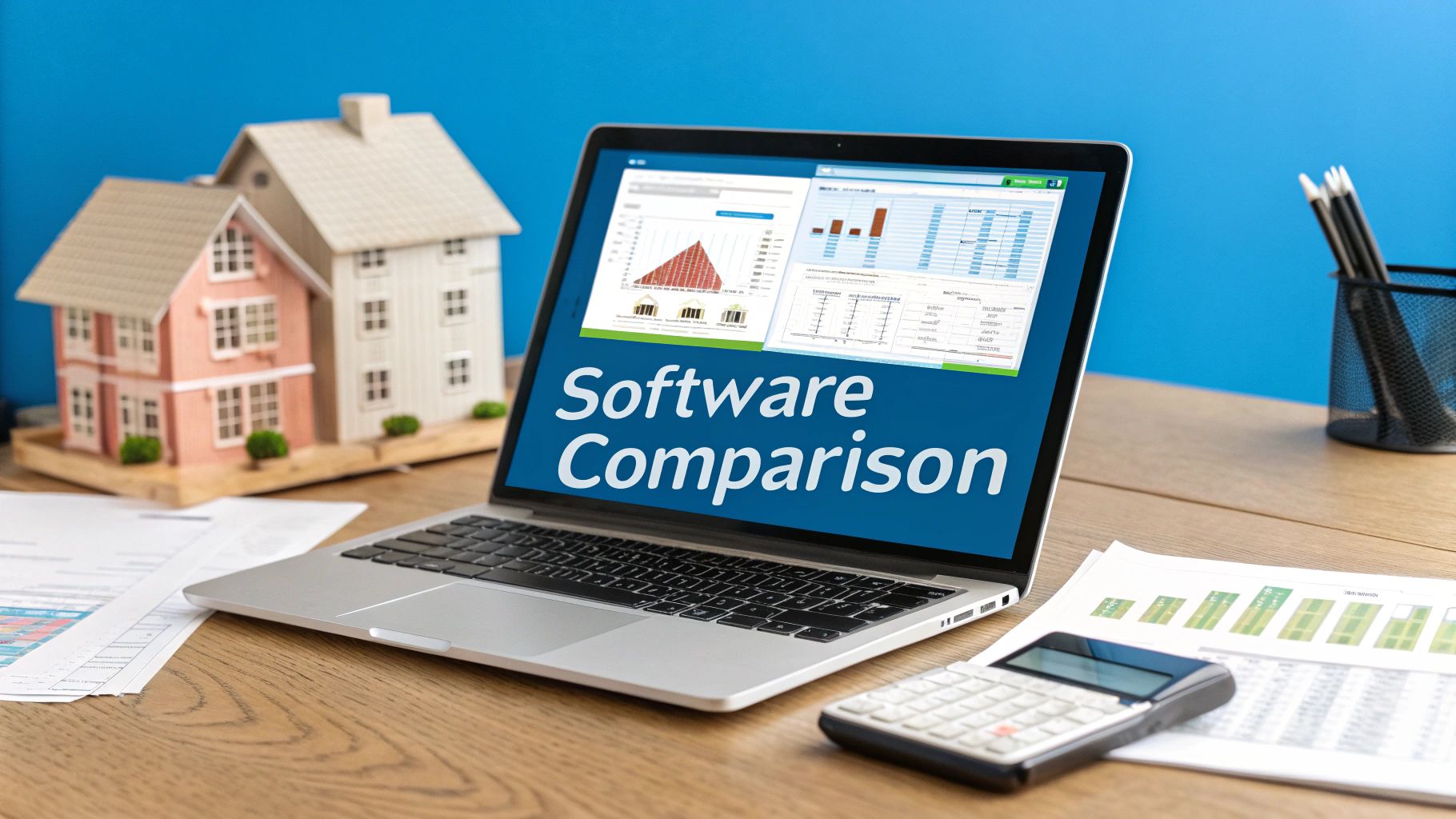For property management companies juggling portfolios of 100 to 10,000+ units, the rental application approval process isn't just an administrative task—it's a critical financial lever. Every day an application sits idle is a day of lost revenue, directly inflating Days on Market (DOM) and eroding portfolio-wide net operating income (NOI).
Why an Unoptimized Application Process Is a Drag on Portfolio Revenue
At an enterprise scale, the velocity and efficiency of your leasing funnel dictate financial performance. A cumbersome, manual application process is a significant bottleneck. Across a distributed portfolio, these seemingly small delays multiply, turning minor administrative lags into substantial revenue leakage. When compounded by high application volumes and the increasing sophistication of rental fraud, you have a recipe for costly delays that directly impact the bottom line.
A high-velocity application workflow isn't just a procedural step—it's a core driver of operational performance and revenue. Mastering it provides a powerful competitive advantage in reducing vacancy loss.
The Stages of Application Approval
At its core, the approval process moves an applicant from prospect to tenant. This infographic breaks down the three primary stages every application passes through, from submission to final decision.

Each stage represents a potential point of friction or delay. This underscores the necessity of a standardized, scalable system to maintain momentum and accuracy across hundreds or thousands of applications simultaneously.
A modern, streamlined process propels prospects through these stages faster, minimizing friction and reducing the likelihood they will lease from a competitor. Below is a breakdown of what this optimized workflow looks like at scale.
Key Stages in a Modernized Application Process
This table breaks down the essential stages of an efficient, scalable rental application approval workflow, highlighting the primary objective for each phase and its impact on key performance indicators (KPIs) for large portfolios.
By optimizing each stage, property managers can significantly reduce turnaround times, cut vacancy loss, and improve overall portfolio performance.
The Rising Threat of Application Fraud
On top of process delays, a growing threat is disrupting operations: rental application fraud. The problem has escalated, making robust, automated verification more critical than ever.
In recent years, the rate of fraudulent rental applications has surged. A staggering 85% of landlords reported being victims of rental fraud—a significant increase from 66% just a year prior. You can get a deeper look at these numbers by reading the full research on tenant fraud statistics.
For enterprise-level portfolios, this isn't just a minor headache; it's a direct assault on asset performance. A single fraudulent tenant can result in over $10,000 in eviction costs and months of lost rent. That makes AI-powered fraud detection a non-negotiable component of any modern rental application approval process.
Standardizing Screening Criteria Across Your Portfolio

When managing properties across multiple markets, consistency is the foundation of a scalable, defensible operation. A standardized rental application approval process is what separates efficient, data-driven organizations from those struggling with operational risk.
Without a single, clear set of screening rules, decisions become inconsistent, exposure to Fair Housing Act (FHA) violations increases, and the overall quality of the tenant base can decline. It's a recipe for operational drag and financial liability.
A documented screening policy removes guesswork. It provides leasing teams with a clear playbook to make rapid, fair, and legally compliant decisions. Every applicant, regardless of the property or market, is measured against the same objective criteria. This is how you mitigate legal exposure and achieve predictable, high-quality outcomes at scale.
Core Components of a Scalable Screening Policy
An effective screening policy must be comprehensive yet simple enough for your entire team to execute consistently. It is the rulebook for vetting applicants, focused squarely on the financial and historical indicators that predict a successful tenancy.
Your standardized criteria should always include these four pillars:
- Income-to-Rent Ratio: Establish a non-negotiable minimum, such as requiring gross monthly income to be 3x the monthly rent. This ensures new tenants possess the financial stability to meet their obligations.
- Credit Score Threshold: Set a clear minimum credit score that aligns with your portfolio's risk tolerance.
- Criminal Background Checks: Define specific, non-discriminatory criteria for reviewing criminal histories, ensuring compliance with all federal and local regulations.
- Eviction and Rental History: Maintain a firm policy on past evictions and a verifiable process for confirming a positive rental history with previous landlords.
This financial scrutiny is more critical than ever. With 85% of landlords recently increasing rents to offset rising operational costs, you must be confident an applicant can meet these new demands. The rental application approval process is your first line of defense in protecting asset value.
By standardizing these metrics, you transform approvals from a subjective judgment into a data-driven system. For any portfolio manager focused on reducing DOM and boosting revenue, this framework is essential, not optional.
Ensuring Compliance and Fairness at Scale
A major benefit of standardization is robust FHA compliance. Applying the same policy to every applicant creates a powerful defense against accusations of discrimination, proving that decisions are based on objective business logic, not personal bias.
To ensure you're onboarding reliable tenants, conducting thorough background checks is a fundamental step. It's about verifying application data and assessing a prospect’s overall risk profile.
Integrating these checks into a standard, automated workflow ensures they are performed consistently and legally for every applicant. This systematic approach protects your operations, your assets, and your brand reputation as you scale.
Automating Application Intake and Pre-Screening
Manual data entry is a significant time and resource drain. It's a major bottleneck in the rental application approval process, especially for large-scale portfolios. Every minute your team spends manually keying in applicant information is a minute not spent on leasing activities, which directly inflates your Days on Market (DOM) and slows down the entire leasing cycle.
The top of your application funnel is the first—and best—place to implement automation.
Automating application intake immediately frees up your staff. Instead of being buried in hundreds of applications, the system captures and organizes all the data for them. This allows your leasing team to transition from data entry clerks to strategic leasing professionals focused on engaging high-intent, pre-qualified prospects ready to sign a lease.
Streamlining Initial Verifications
Once an application enters your system, automation can begin initial checks in seconds. This serves as your first line of defense, filtering out incomplete or clearly unqualified submissions without any manual intervention. An automated workflow can instantly flag any application that fails to meet your basic, non-negotiable criteria.
This first-pass automation can handle tasks like:
- Completeness Checks: The system can automatically reject applications with missing fields or documents, notifying the applicant of what is needed for resubmission.
- Income Verification: It can instantly calculate and compare the applicant’s stated income to your required income-to-rent ratio (e.g., 3x the rent) and flag any that fall short.
- ID Validation: AI-powered tools can perform a quick, initial check on an applicant's government-issued ID to confirm its legitimacy.
This automated gatekeeping ensures your team’s valuable time is spent only on applicants who have a realistic chance of being approved. Understanding how AI revolutionizes applicant tracking systems can provide a blueprint for setting this up for maximum efficiency.
For a portfolio managing over 1,000 units, automating this single stage can slash 24-48 hours from the approval timeline. That velocity doesn't just improve the applicant experience; it directly reduces vacancy loss and boosts your NOI.
The Impact on Lead Conversion and Speed-to-Lease
Ultimately, automating the front end of the rental application approval process is about achieving speed and strategic focus. Eliminating manual data entry and basic checks puts the entire lead-to-lease cycle into a higher gear. In a competitive rental market, that speed is a significant operational advantage.
By identifying your most promising applicants almost instantly, you can advance them to the next stage—like detailed screening or an on-demand tour—before they are lost to a competitor. Faster processing times directly improve lead-to-lease conversion rates, which means placing qualified, rent-paying tenants in your properties sooner.
For more strategies to accelerate leasing, see our guide on 7 ways to lease quicker and cheaper. By focusing your team’s energy on high-value activities, you’re not just filling a vacancy; you’re building a more efficient, profitable, and scalable operation.
Using Advanced Tech to Detect and Prevent Fraud

As the rental market becomes more competitive, application fraud is becoming a major operational risk for large-scale property managers. A simple visual document review is no longer sufficient. Today's fraudsters use sophisticated tools to generate fake pay stubs and bank statements that appear authentic to the human eye.
This is a widespread problem. One recent report found that a staggering 93% of property managers encountered rental fraud in the past year. Falsified proof of income or employment is the most common method, a problem exacerbated by rent growth outpacing wages. This creates immense pressure on applicants and significant risk for property owners.
For a multi-market portfolio, allowing even a few fraudulent tenants to slip through can trigger massive financial losses from eviction costs, property damage, and extended vacancy.
AI-Powered Document Analysis
To combat this, leading property management companies are leveraging AI-powered document verification technology. These systems perform analysis far beyond a simple visual scan.
They analyze a document's digital forensics, searching for anomalies invisible to a leasing agent. This includes analyzing metadata, font inconsistencies, pixel-level alterations, and other digital fingerprints that indicate a document has been doctored.
Think of it as a forensic investigation for every application. The system can instantly detect a pay stub where figures were digitally manipulated or a bank statement altered in Photoshop. This delivers a level of security that manual reviews simply cannot match.
This technology is no longer a "nice-to-have"—it's a critical security layer for protecting revenue and ensuring the stability of your tenant base in the rental application approval process.
Mini-Case Study: A 2,000+ Unit PM Company
A property management company with a distributed portfolio of over 2,000 single-family rentals was experiencing significant losses from fraudulent applications that bypassed their manual review process. After several costly evictions, they integrated an automated document verification platform into their application workflow.
The results were immediate and impactful:
- 70% Reduction in Fraud: The system began flagging suspicious documents instantly, leading to a 70% decrease in fraudulent applications being approved.
- Significant Cost Savings: By preventing just a handful of evictions, the company saved tens of thousands of dollars in legal fees and lost rent—a clear and measurable ROI.
- Faster, More Confident Decisions: With financial data automatically authenticated, leasing agents could approve applications with greater confidence and speed, contributing to a measurable reduction in their Days on Market.
By adopting advanced fraud detection, you can build a powerful defense against the rising tide of rental scams. For more on this, see our guide on how Showdigs is solving the growing epidemic of rental scams and learn how to better protect your portfolio.
Consolidating Screening Results for Faster Decisions
The biggest drag on your rental application approval process is often not a single slow step, but the time lost compiling disparate data. For large portfolios, manually retrieving information from separate credit, criminal, and eviction reports is a classic bottleneck. This fragmented process creates delays, frustrating both your team and your prospective tenants.
To reduce Days on Market (DOM), you must transition from a fragmented workflow to a unified one. This is where API integrations become a game-changer for property management at scale. By connecting your screening services directly into your core Property Management System (PMS), you create a single source of truth for every applicant.
Building a Complete Applicant Picture
Instead of your team toggling between multiple browser tabs and PDFs, an integrated system consolidates all critical data into a single, unified dashboard. This provides leasing managers with a complete applicant profile at a glance, with all essential information readily available.
This integrated setup enables a much more intelligent approval workflow:
- Automatic Scoring: The system can instantly score applicants against your portfolio-wide screening criteria, providing a clear risk assessment based on credit score, income, and rental history.
- Smart Red Flags: You can configure the system to automatically flag applications that fall outside your defined risk tolerance, such as a prior eviction or a credit score below your minimum threshold.
An integrated system allows your team to shift from data collectors to decision-makers. They get the full picture instantly, enabling faster, more consistent, and data-driven approvals that align with your corporate standards.
The Real-World Financial Impact
The impact of this efficiency on revenue is direct and significant. Consider a 1,000-unit portfolio with an average monthly rent of $1,800 and a 40% annual turnover. Every single day of vacancy costs your portfolio approximately $24,000 in lost revenue over the course of a year.
By integrating your screening results, you can easily shave at least 24 hours from your average approval time. That one day of regained occupancy across your turning units puts that revenue directly back into your pocket. This isn't just an operational tweak; it's a clear strategy for boosting your portfolio's NOI. It transforms the rental application approval process from a cost center into a powerful revenue-generation tool.
Calculating the ROI of an Optimized Approval Workflow

For any enterprise-level property manager, every modification to the rental application approval process must answer one critical question: what is the financial impact? Upgrading your workflow isn't merely about operational tidiness; it’s about directly driving portfolio profitability.
Calculating the return on investment (ROI) is how you build the business case. It provides the hard data to demonstrate that a faster, more intelligent process isn't a cost—it's a revenue generator.
Key Pillars of Application ROI
A high-velocity, accurate approval system creates value in several core areas. When running the numbers, these are the high-impact zones to focus on:
- Reduced Vacancy Loss: This is the most immediate and significant return. Every day shaved off the approval cycle is a day of recaptured rent, directly reducing your Days on Market (DOM).
- Lower Eviction Costs: Better screening leads to higher-quality tenants. By leveraging automation and robust fraud detection, you filter out high-risk applicants, significantly reducing the frequency of costly and operationally draining evictions.
- Improved Operational Efficiency: Quantify the staff hours spent on manual, repetitive tasks for each application. Automating this work lowers your cost-per-door and frees up your leasing team for high-value, revenue-generating activities like closing leases.
For a large portfolio, the financial model is incredibly compelling. A small efficiency gain on a single application, when multiplied across thousands of units, translates into substantial annual savings and revenue growth.
The table below models the direct revenue impact of reducing DOM for a 1,500-unit portfolio. As you can see, saving even a few days per vacancy cycle adds up quickly.
DOM Reduction Impact on Annual Revenue (Example: 1,500 Unit Portfolio)
This table illustrates the direct financial benefit of accelerating the application approval process, showing how saving days per vacancy significantly boosts annual revenue.
The numbers don't lie. A faster, more efficient approval process pays for itself many times over by keeping your properties occupied and your revenue stream consistent.
For more strategies to achieve these results, explore our guide on ways to boost ROI for property managers.
Your Top Questions About the Rental Application Process
Even with the most streamlined rental application approval process, questions arise. At an enterprise scale, these questions become more complex, touching on workflow, compliance, and technology integration. Here are some of the most common inquiries from large-scale property managers working to optimize their operations.
How Long Should an Approval Take at Scale?
For a portfolio of hundreds or thousands of units, the target turnaround time for a decision should be 24 to 48 hours. While outliers will always exist—such as waiting on a slow-to-respond reference—a well-automated system should consistently achieve this benchmark.
Longer times indicate bottlenecks that are directly increasing your Days on Market (DOM) and costing you revenue. Speed is a direct reflection of your leasing funnel's health.
The longer an applicant waits, the higher the probability they will sign a lease with a competitor. A 24-hour turnaround is not just good customer service; it's a significant competitive advantage that boosts lead-to-lease conversion rates.
Can We Automate Communication with Applicants?
Absolutely—in fact, automation is non-negotiable for managing high application volume without overwhelming your team. Your Property Management System (PMS) or an integrated PropTech solution can manage key touchpoints:
- Confirmation: An instant email confirming successful application submission provides peace of mind for the applicant with zero manual effort.
- Status Updates: Automated messages informing applicants their file is under review keeps them engaged and reduces inbound "just checking in" calls.
- Information Requests: System-generated emails can automatically flag and request missing documents, keeping the process moving without manual intervention from your team.
This simple automation framework enhances the applicant experience and frees up your leasing agents to focus on high-touch, value-add activities.
What Is the Best Way to Handle Denials?
Handling denials requires a process that is swift, compliant, and professional. The key is a standardized process across your entire portfolio, without exception.
Always send a formal, written notice. To ensure compliance with Fair Housing laws, the reason for denial must be tied directly to your pre-set, objective screening criteria. The most effective method is using a templated adverse action notice that can be automatically populated and sent. This ensures consistency and significantly minimizes legal risk at scale.
Ready to eliminate manual bottlenecks and transform your rental application approval process into a streamlined, revenue-driving engine? Showdigs combines intelligent automation with an on-demand network of showing agents to slash your DOM and get properties leased faster. Learn how Showdigs can help you scale your operations.







